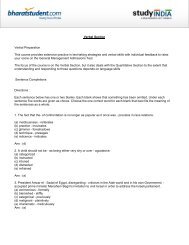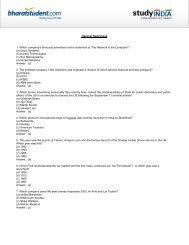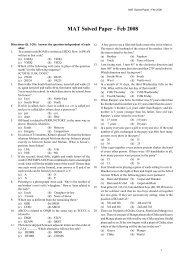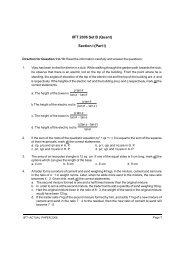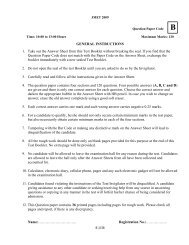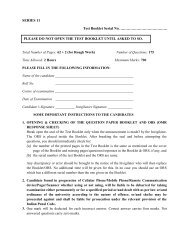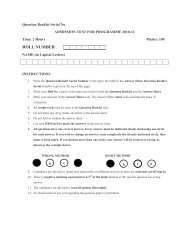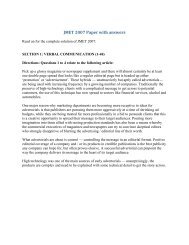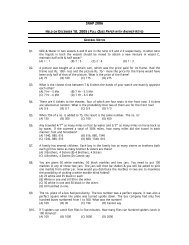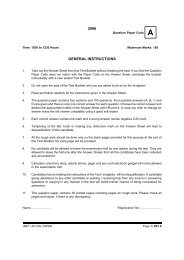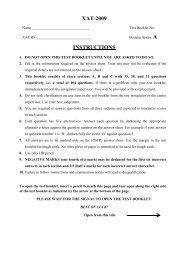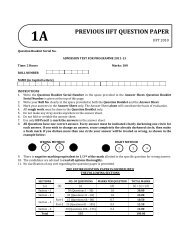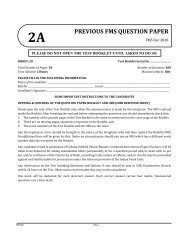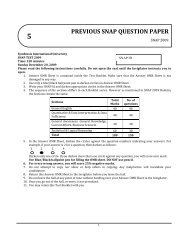FMS Actual Paper – 2007 (Memory Based Questions)
FMS Actual Paper – 2007 (Memory Based Questions)
FMS Actual Paper – 2007 (Memory Based Questions)
Create successful ePaper yourself
Turn your PDF publications into a flip-book with our unique Google optimized e-Paper software.
<strong>FMS</strong> <strong>Actual</strong> <strong>Paper</strong> <strong>–</strong> <strong>2007</strong> (<strong>Memory</strong> <strong>Based</strong> <strong>Questions</strong>)<br />
1. A straight line is perpendicular to the straight line 2x + 3y = 5 and it passes through the point (1, 1).<br />
Which of the following gives its equation?<br />
a. 2x <strong>–</strong> 3y = 1 b. 2x + 3y = 2 c. 3x + 2y = 1 d. 3x <strong>–</strong> 2y = 1<br />
2. A straight line passes through the point (3, 2) and is perpendicular to the straight line x+ y = 3 and<br />
is perpendicular to the straight line x + y = 3. Find its equation.<br />
a. x + y + 1 = 0 b. x <strong>–</strong> y <strong>–</strong> 1 = 0 c. x <strong>–</strong> y + 1 = 0 d. x + y <strong>–</strong> 1 = 0<br />
3. The vertices of a triangle lie on points (0, 4), (3, 5) and (<strong>–</strong>1, <strong>–</strong>1) in the X <strong>–</strong> Y plane. Which of the<br />
following is correct about this triangle?<br />
a. It is an isosceles right triangle. b. It is a right triangle.<br />
c. It is an equilateral triangle d. It is an obtuse triangle.<br />
4. Find the length of the altitude of an equilateral triangle whose sides have a length of 3 3 units.<br />
a. 8.5 units b. 6.5 units c. 4.5 units d. 2.5 units<br />
5. If a = log2, b = log 3 and c = log 7 then find the value of log 6 7 in terms of a, b and c.<br />
a. b<br />
a+ c<br />
<strong>FMS</strong> / ACTUAL PAPER <strong>2007</strong><br />
b. c<br />
a+ b<br />
c. a<br />
b+ c<br />
d. None of these<br />
6. If the real number x lies between 2 and 3, then which of the following expressions is valid?<br />
a. (x <strong>–</strong> 2) (x <strong>–</strong> 3) = 0 b. (x <strong>–</strong> 2) (x <strong>–</strong> 3) < 0<br />
c. x− 2 > x−3 d. None of these<br />
7. Solve for all values of x for which 2<br />
6+ x −x ≥ 0<br />
a. −2 ≤ x ≤ 3 b. 2 ≤ x ≤ 3<br />
c. −3 ≤ x ≤ 2 d. −3 ≤ x ≤−2<br />
3 3 3 3<br />
1 + 2 + 3... + 12<br />
8. Evaluate the expression<br />
2 2 2 2<br />
1 + 2 + 3... + 12<br />
a. 234<br />
25<br />
100<br />
b. 224<br />
35<br />
c. 324<br />
35<br />
d. 335<br />
24<br />
9.<br />
⎛1+ i⎞<br />
Evaluate ⎜ ⎟<br />
⎝1−i⎠ a. 0 b. 1 c. <strong>–</strong>1 d.100<br />
Page 1
6 6<br />
⎛1+ i 3 ⎞ ⎛1−i 3 ⎞<br />
10. Find the value of the expression<br />
+<br />
⎜ ⎟ ⎜ ⎟<br />
1− i 3<br />
⎟ ⎜<br />
1+ i 3<br />
⎟<br />
⎝ ⎠ ⎝ ⎠<br />
Page 2<br />
a.0 b.2 c.128 d. None of these<br />
11. Evaluate log34×log45×log56×log67×log78×log89 a.0 b.1 c.<strong>–</strong>1 d. None of these<br />
12. If the sum of the roots of the equation x 2 + ax + 1 = 0 is equal to the sum of the squares of their<br />
reciprocals, then which of the following is a possible value of a?<br />
a. <strong>–</strong>1 b. 2 c.1 d. None of these<br />
13. If the straight lines ax <strong>–</strong> by = k and cx <strong>–</strong> dy = k 1 are perpendicular to each other, then what is the<br />
relation between a, b, c & d?<br />
a. ab + cd= 0 b. ab <strong>–</strong> cd = 0 c. ac <strong>–</strong> bd = 0 d. ac + bd = 0<br />
14. The sum of the infinite series<br />
2 3<br />
x x<br />
1 - x + − + ... ∞ is denoted by<br />
2! 3!<br />
a. sin x + cos x b. 1 + log (1 <strong>–</strong> x) c. 1 <strong>–</strong> log (1 + x) d. None of these<br />
∞<br />
15.<br />
1<br />
The value of ∑ is<br />
n= 12n(2n+<br />
1)<br />
a. 1 <strong>–</strong> log 2 e b. 1 + log 2 e c. log 2 e d. log e 2<br />
16. If 2 +3x <strong>–</strong> 2x 2 < 0, then x is given by<br />
a. 1<br />
1<br />
1<br />
− < x < 2 b. x
20.<br />
logx logy logz<br />
If = =<br />
2 2 2 2 2 2<br />
a + b + ab b + c + bc c + a + ac<br />
a. 0 b. 1 c. abc d. (xyz) abc<br />
21. Solve the equation for x, 2.x + 2.x = 5.<br />
a. 1<br />
2, 2<br />
22. 3 .000064 simplifies to<br />
<strong>FMS</strong> / ACTUAL PAPER <strong>2007</strong><br />
b.<br />
1 −1<br />
3 3<br />
1<br />
4, 4<br />
then, the value of (a−b) (b−c) (c− a)<br />
x .y .z is<br />
c.<br />
1<br />
6, 6<br />
d. 1<br />
8, 8<br />
a. 0.2 b. 0.02 c. 0.4 d. 0.04<br />
23. Simplify the expression 6 4<br />
(1 + i ) + (1 + i ) .<br />
a. −4−8i b. 4 <strong>–</strong> 8i c. 8 <strong>–</strong> 4i d. 8 + 4i<br />
24. In a post graduate college, 5% of the students are married and 25% of the married students ae<br />
females. Further, 60% of the students are neither married nor females. Which of the following<br />
statements are valid?<br />
I. There is 1 married female student for every 28 unmarried female students.<br />
II. There is 1 married male student for every 4 unmarried male students.<br />
a. I b. II c. Both I and II d. None<br />
25. An amount of Rs12500 was deposited for a period of 3 years at a compound interest rate of 20%.<br />
What will be the amount of money, in rupees, at the end of 3 years?<br />
a. 21600 b. 22600 c. 23600 d. None of these<br />
26. The market price of a machine depreciates at an annual compound rate of 10%. If the current<br />
market price of the machine is Rs. 8748 then what was its market price 3 years ago?<br />
a. Rs. 12500 b. Rs. 12000 c. Rs. 20000 d.Rs. 20500<br />
27. A cylinder has a diameter of 8cm and a cuboid has a square base of side length 8cm. If both of these<br />
solids have a height of 14 cm then what is the difference in their volumes?<br />
a.196 cc b.1960 cc c.1920 cc d.195 cc<br />
28. A metallic cuboid has dimensions of 9cm × 10cm × 11cm. How many spherical balls of radius 0.3<br />
cm, can be drawn from this cuboid?<br />
a. 2750 b. 5750 c. 8750 d. 3750<br />
29. A cylinder of diameter 10 cm and a height of 20 cm is filled with water. If a sphere of diameter 10 cm<br />
is completely submerged inside the cylinder, what will be the increase in the level of water, in the<br />
cylinder?<br />
a. 3.33 cm b. 6.67 cm c. 8.33 cm d. cannot be determined<br />
Page 3
30. Four brothers and three sisters sit in a single row, facing the photographer’s camera. If the three<br />
sisters always sit together, how many different photographs, having all of them, can be eliked?<br />
a.840 b.126 c.120 d.720<br />
31. From amongst the available 15 cricket players, of whom 5 are bowlers, a team of 11 is to be<br />
selected. What is the probability that the selected team will have at least 3 bowlers?<br />
Page 4<br />
a. 7<br />
13<br />
b. 5<br />
13<br />
c. 12<br />
13<br />
(a+ ib)<br />
32. The imaginary part of the complex number is given by<br />
(c−id) ac+ bd<br />
a. 2 2<br />
c −d<br />
ac−bd b. 2 2<br />
c + d<br />
ad−bc c. 2 2<br />
c −d<br />
d. 9<br />
13<br />
ad+ bc<br />
d. 2 2<br />
c + d<br />
33. The area of a triangle is 21 sq. units. If two of its vertices lie on points (5, 3) and (<strong>–</strong>4, <strong>–</strong>3), then find<br />
the locus of the third vertex.<br />
a. 2x <strong>–</strong> 3y = 15 b. 2x + 3y = 15 c. 3x + 2y = 15 d. 3x <strong>–</strong> 2y = 15<br />
34. The profit by selling an item was 25%. If the item was marked 40% above the selling price then what<br />
is the ratio of the marked price to the cost price of the item?<br />
a. 5<br />
4<br />
b. 7<br />
4<br />
35. The per liter price of vehicular fuel has increased by 25%. If the transportation cost is still the same,<br />
then what is the ratio of the reduced fuel consumption to the previous fuel consumption?<br />
a. 1:5 b. 1:4 c. 1:3 d. 1:6<br />
36. The arithmetic mean of the k th and the l th terms of an A.P. is equal to the arithmetic mean of the m th<br />
and the n th terms of the same A.P. Find the value of (m + n).<br />
a. l <strong>–</strong> k b. k <strong>–</strong> l c. l + k d. None of these<br />
37. A very small ball lies at the point (3, 2) in the X <strong>–</strong> Y plane. The ball is now shifted by 5 units towards<br />
the negative Y-axis. If Y-axis were a mirror, then at what point will the image of this ball, lie?<br />
a. (<strong>–</strong>3, <strong>–</strong>3) b. (<strong>–</strong>3, <strong>–</strong>2) c. (<strong>–</strong>2, <strong>–</strong>2) d. (<strong>–</strong>2, <strong>–</strong>3)<br />
c. 3<br />
4<br />
d. 1<br />
4<br />
38. In the X <strong>–</strong> Y plane, three lines are concurrent. Their equations are<br />
3x + 4y = 6<br />
5x + 4y = 4<br />
zx + 4y = 5<br />
Find the value of the constant z.<br />
a. 23 b. 25 c. 27 d. 29<br />
<strong>FMS</strong> / ACTUAL PAPER <strong>2007</strong>
39. If the following three lines pass through the same point in the X <strong>–</strong> Y plane, then find the value of<br />
(a + b).<br />
3x <strong>–</strong> 2y = 1<br />
5x + 4y = 9<br />
ax + by = 3<br />
a. 0 b.1 c.2 d.3<br />
40. If ax +by + c = 0 and dx + ey + f = 0 represent the same straight line then which of following is<br />
necessarily satisfied?<br />
a. a = d, b = e and c = f<br />
a b c<br />
b. = =<br />
d e f<br />
c. ad + be + cf = 0 d. None of these<br />
Directions for questions 41 to 45: Answer the questions on the basis of the information given below.<br />
The following pie chart gives the percentage wise break up of the cost price of a machine. Study the pie<br />
chart and answer the questions that follow.<br />
<strong>FMS</strong> / ACTUAL PAPER <strong>2007</strong><br />
Overhead Costs<br />
(15%)<br />
Packaging Cost<br />
(35%)<br />
Other Costs<br />
(28%)<br />
Marketing<br />
Cost<br />
(18%)<br />
Labour Cost (4%)<br />
41. If the "Labour Cost" of a single unit of machine is Rs.2500 then what is the per unit "Marketing Cost"<br />
of the machine?<br />
a. Rs. 1125 b. Rs. 112500 c. Rs. 11250 d. none of these.<br />
42. What is the angle subtended by the "Overheads Cost" at the centre of the circle, in the above pie<br />
chart?<br />
a. 15° b. 75° c. 54° d. 45°<br />
43. How much more is the per unit "Packaging Cost" with respect to the per unit "Marketing Cost"?<br />
a. 94.44% b. 84.44% c. 104.44% d. none of these<br />
44. If the per unit "Packaging Cost" cost of the machine is reduced by 10% then what will be the change<br />
in the per unit cost price of the machine?<br />
a. <strong>–</strong>2.5% b. <strong>–</strong>10% c. <strong>–</strong>1.5% d. <strong>–</strong>3.5%<br />
Page 5
45. Which of the following is true?<br />
a. The sum of per unit "Other Costs" and the "Labour Cost" add up to the per unit "Packaging<br />
Cost"<br />
b. The sum of per unit "Overhead Cost" and the "Marketing Cost" add up to the per unit "Packaging<br />
Cost"<br />
c. The sum of per unit "Other Cost" and the "Marketing Cost" add up to the per unit "Packaging<br />
Cost"<br />
d. none of these.<br />
Directions for questions 46 to 50: Answer the questions on the basis of the information given below.<br />
The following bar graph shows the annual comparisons of the "Targeted Production" with the "<strong>Actual</strong><br />
Production" for a manufacturing plant. Study the bar graph and answer the questions that follow.<br />
Page 6<br />
Production (in units)<br />
300<br />
275<br />
450<br />
425<br />
350<br />
325<br />
600<br />
675<br />
500<br />
625<br />
1999-2000 2000 - 2001 2001 - 2002 2002 - 2003 2003 - 2004<br />
Target<br />
<strong>Actual</strong><br />
46. What is the ratio of the "Targeted Production" to the "<strong>Actual</strong> Production" in the year 2000 - 2001?<br />
a. 11<br />
12<br />
b. 17<br />
18<br />
c. 15<br />
16<br />
d. 19<br />
20<br />
47. What percent of the "Targeted production" was met by the "<strong>Actual</strong> Production", in the year 2002 -<br />
2003?<br />
a. 112.5% b. 12.5% c. 125% d. 120.5%<br />
48. Which of the following two consecutive years have followed the same trend of "<strong>Actual</strong> Production"<br />
with respect to the "Targeted Production"?<br />
a. 1999<strong>–</strong>2000 and 2001<strong>–</strong>2002 b. 2000<strong>–</strong>2001 and 2002<strong>–</strong>2003<br />
c. 2001<strong>–</strong>2002 and 2000<strong>–</strong>2001 d. 2002<strong>–</strong>2003 and 2003<strong>–</strong>2004<br />
<strong>FMS</strong> / ACTUAL PAPER <strong>2007</strong>
49. In which of the following years the "<strong>Actual</strong> Production" surpassed the "Targeted Production" by the<br />
maximum percentage?<br />
a. 1999-2000 b. 2000-2001 c. 2002-2003 d. 2003-2004<br />
50. Which of the following statements is correct about the cumulative production of the plant from the<br />
year 1999 to the year 2004?<br />
a. The cumulative "<strong>Actual</strong> Production" has missed the cumulative "Targeted Production" by less<br />
than 10%.<br />
b. The cumulative "<strong>Actual</strong> Production" has surpassed the cumulative "Targeted Production" by<br />
more than 10%<br />
c. The cumulative "<strong>Actual</strong> Production" has missed the cumulative "Targeted Production" by more<br />
than 10%.<br />
d. The cumulative "<strong>Actual</strong> Production" has surpassed the cumulative "Targeted Production" by<br />
less than 10 %<br />
<strong>FMS</strong> / ACTUAL PAPER <strong>2007</strong><br />
Page 7
<strong>–</strong>1 3<br />
1. d Slope of the, line = =<br />
<strong>–</strong>2 2<br />
3<br />
Equation is<br />
y<strong>–</strong>1 3<br />
= or 3x <strong>–</strong> 2y = 1<br />
x<strong>–</strong>1 2<br />
Hence (d) is the correct answer.<br />
<strong>–</strong>1<br />
2. b Slope of the line = = 1<br />
<strong>–</strong>1<br />
3. d<br />
4. c<br />
Answers and Explanations<br />
equation is y<strong>–</strong>2 1<br />
x<strong>–</strong>3 =<br />
or x <strong>–</strong> y = 1<br />
Hence (b).<br />
(0, 4) C<br />
A<br />
(<strong>–</strong>1, <strong>–</strong>1)<br />
y<br />
( )<br />
B(3,<br />
5)<br />
3 1<br />
Slopes of lines AB, BC & AC are , and5 .<br />
2 3<br />
The length of the sides AB, BC and AC are<br />
52 units, 10 units and 26 units.<br />
As. AC 2 + BC 2 < AB 2 ; It is an obtuse triangle. Hence (d).<br />
A<br />
a<br />
60°<br />
h<br />
B D C<br />
a= 3 3units<br />
2 2 2<br />
AB BD AD<br />
= +<br />
2<br />
2 ⎛a⎞ 3 3<br />
or h = a <strong>–</strong> ⎜ ⎟ = a = × ( 3 3)<br />
⎝2⎠ 2 2<br />
or h = 4.5 units. hence (c) is correct.<br />
x<br />
<strong>FMS</strong> ACTUAL PAPER <strong>2007</strong> Page 1<br />
5. b<br />
7 log7 log7 c<br />
log6<br />
= = =<br />
log6 log2+ log3 a+ b<br />
Hence, (b) is correct.<br />
6. c If x lies between 2 and 3 then it is greater than 2 and<br />
less than 3.<br />
7. a<br />
8. a<br />
9. b<br />
10. b<br />
⇒ ( x<strong>–</strong>2) > 0and<br />
(x <strong>–</strong> 3) < 0<br />
⇒ ( x<strong>–</strong>2) ( x<strong>–</strong>3) < 0 . Hence (b) is always correct.<br />
(a) is incorrect and (c) is correct for some values of x,<br />
only.<br />
2<br />
6 x<strong>–</strong>x 0<br />
+ ≥<br />
2<br />
⇒ x <strong>–</strong>x<strong>–</strong>6 ≤0<br />
or ( x+ 2) ( x<strong>–</strong>3) ≤0<br />
⇒<strong>–</strong>2≤x ≤3<br />
Hence (a) is correct.<br />
1<br />
3<br />
+ 2<br />
3<br />
+ 3<br />
3<br />
+ ........12<br />
3<br />
2 2 2 2<br />
1 + 2 + 3 + ........ + 12<br />
2<br />
⎧⎪12( 12+ 1)<br />
⎫⎪<br />
⎨ ⎬<br />
⎪ 2 ⎪ 234<br />
=<br />
⎩ ⎭<br />
=<br />
12 12 1 12 2 1 25<br />
( + ) ( × + )<br />
6<br />
Hence (a) is correct.<br />
2 2<br />
1+° i 1+° i + 2i°<br />
= = =° i<br />
1<strong>–</strong>i° 2 2 1+ 1<br />
( 1+° i )<br />
( 1 ) <strong>–</strong> ( i°<br />
)<br />
2 ( )<br />
100<br />
⎛1+° i ⎞<br />
50<br />
⎜ ⎟ = i° = 1<br />
⎝1<strong>–</strong>i° ⎠<br />
Hence (b) is correct.<br />
6 6<br />
⎛ <strong>–</strong>1+ i 3 ⎞ ⎛ <strong>–</strong>1<strong>–</strong>i 3⎞<br />
=<br />
⎜ ⎟ +<br />
⎜ ⎟<br />
⎝ 2 ⎠ ⎝ 2 ⎠<br />
( +<br />
2<br />
)<br />
( ) ( )<br />
( )<br />
( ) ( )<br />
⎛ ⎞ ⎛ ⎞<br />
⎜ 1 i 3 ⎟ ⎜ 1<strong>–</strong>i 3 ⎟<br />
= ⎜ ⎟ +<br />
2 2 ⎜ 2 2⎟<br />
⎜ 1 <strong>–</strong> i 3 ⎟ ⎜ 1 <strong>–</strong> i 3 ⎟<br />
⎝ ⎠ ⎝ ⎠
11.<br />
Page 2<br />
6 6<br />
⎛ <strong>–</strong>1+ i 3 ⎞ ⎛ <strong>–</strong>1<strong>–</strong>i 3⎞<br />
= +<br />
⎜ ⎟ ⎜ ⎟<br />
2 ⎟ ⎜ 2 ⎟<br />
⎝ ⎠ ⎝ ⎠<br />
6 2 6<br />
= ( ω) + ( ω )<br />
{ ωis a cube root of unity}<br />
=( ω 3 ) 2 + ( ω 3 ) 4<br />
= 1 + 1<br />
= 2.<br />
4 5 6 7 8 9<br />
log3× log4× log5× log6× log7× log<br />
8<br />
log4 log5 log6 log7 log8 log9<br />
= × × × × ×<br />
log3 log4 log5 log6 log7 log8<br />
log9<br />
2<br />
9 3<br />
= = log = log = 2<br />
log3 3 3 .<br />
12. c Let roots are αβ , .<br />
2<br />
1 1 ( α+β) −2αβ ( α+β ) = + =<br />
2 2 2<br />
α β ( αβ)<br />
2<br />
( −a) − 2 × (1)<br />
⇒− a =<br />
2<br />
(1)<br />
2<br />
⇒ a + a− 2= 0<br />
⇒ a =−2or<br />
1.<br />
⇒ (c) is correct.<br />
13. d Slope of line ax <strong>–</strong> by = k is a<br />
b<br />
and the slop of line cx <strong>–</strong><br />
dy = k 1 is <strong>–</strong>c<br />
d<br />
as the two lines are perpendicular to each other,<br />
⎛a⎞ ⎛c⎞ ⎜ × = <strong>–</strong>1<br />
b<br />
⎟ ⎜<br />
d<br />
⎟<br />
⎝ ⎠ ⎝ ⎠<br />
⇒ ac = <strong>–</strong>bd<br />
or ac + bd = 0<br />
Hence (d) is correct.<br />
14. d The infinite series is denoted by e <strong>–</strong>x .<br />
1 ⎛ 1 ⎞ 1<br />
= <strong>–</strong><br />
2n 2n+ 1<br />
⎜<br />
2n<br />
⎟<br />
⎝ ⎠ 2n+ 1<br />
15. a ( )<br />
∞<br />
1 ⎛ 1 1 1 ⎞<br />
∑ = ⎜ + + + ....... ∞<br />
2n<br />
⎟<br />
= ( 2n+ 1<br />
n 1 ) ⎝2.1 2.2 2.3 ⎠<br />
⎛ 1 1 1 ⎞<br />
<strong>–</strong> ⎜ + + + ....... ∞<br />
+ + +<br />
⎟<br />
⎝2.1 1 2.2 1 2.3 1 ⎠<br />
⎛ 1 1⎞ ⎛ 1 1⎞ ⎛ 1 1⎞<br />
= ⎜ <strong>–</strong> ⎟ + ⎜ <strong>–</strong> ⎟ + ⎜ <strong>–</strong> ⎟ + ........ ∞<br />
⎝2 3⎠ ⎝4 5⎠ ⎝6 7⎠<br />
⎡ 1 1 1 1 1 1 ⎤<br />
= <strong>–</strong> ⎢<strong>–</strong> + <strong>–</strong> + <strong>–</strong> + <strong>–</strong>.......... ∞⎥<br />
⎣ 2 3 4 5 6 7 ⎦<br />
⎡⎛ 1 1 1 1 1 ⎞ ⎤<br />
= <strong>–</strong> ⎢⎜1<strong>–</strong> + <strong>–</strong> + <strong>–</strong> + ....... ∞⎟<strong>–</strong>1⎥<br />
⎣⎝ 2 3 4 5 6 ⎠ ⎦<br />
= <strong>–</strong> ⎡ ⎤<br />
⎢<br />
log<br />
2<br />
⎣ e<strong>–</strong>1<br />
⎥⎦<br />
2<br />
= 1<strong>–</strong>loge<br />
e<br />
= log2<br />
e Hence (a) is the correct answer.<br />
16. d 2 + 3x <strong>–</strong> 2x 2 < 0<br />
⇒ ( 2x + 1) ( x<strong>–</strong>2) > 0<br />
<strong>–</strong>1<br />
⇒ x > 2or x <<br />
2<br />
Option (d) is correct.<br />
17. c log (x <strong>–</strong> 7) + log (x +1) = 1<br />
( ) ( )<br />
⇒ log⎣⎡ x<strong>–</strong>7 x + 1 ⎦⎤ = 1= logee ⇒ ( x<strong>–</strong>7) ( x+ 1) = e<br />
2<br />
⇒ x <strong>–</strong>6x<strong>–</strong>7<strong>–</strong>e = 0<br />
Option (e) is correct.<br />
18. c Let x2 + ax + b = 0 has roots ( αβ , )<br />
19. a<br />
and x2 + bx + a = 0 has roots ( αγ , )<br />
α is a root of the equation;<br />
(x 2 + ax + b) <strong>–</strong> (x 2 + bx + a) = 0<br />
or, (a <strong>–</strong> b) x = (a <strong>–</strong>b)<br />
⇒α= 1<br />
From the first equation,<br />
α+β= b⇒ 1 +β= <strong>–</strong>a & αβ= . b⇒1. β= b⇒β= b<br />
Hence a + b = <strong>–</strong>1.<br />
Option (c) is correct.<br />
2<br />
aω + b+ cω= x<br />
2<br />
a b c y<br />
+ ω+ ω =<br />
2<br />
aω+ bω + c = z<br />
Adding the three equations,<br />
2 2 2<br />
a(1 ) b(1 ) c(1 ) x y z<br />
+ω+ω + +ω+ω + +ω+ω = + +<br />
or x + y + z = 0<br />
3 3 3<br />
⇒ x + y + z − 3xyz = 0<br />
Option (a) is correct.<br />
<strong>FMS</strong> ACTUAL PAPER <strong>2007</strong>
logx logy logz<br />
20. b Let = = = k<br />
2 2 2 2 2 2 1<br />
a + b + ab b + c + bc c + a + ac<br />
21. d<br />
and x (a<strong>–</strong>b) .y (b <strong>–</strong> c) . z (c<strong>–</strong>a) = k 2<br />
( a<strong>–</strong>blogx ) + ( b<strong>–</strong>clogy ) + ( c<strong>–</strong>alogz ) = logk2<br />
2 2 2 2<br />
{ ( ) ( ) ( ) ( )<br />
⇒ k1 a<strong>–</strong>b a + b + ab + b<strong>–</strong>c b + c + bc<br />
2 2<br />
( ) ( )}<br />
= c<strong>–</strong>a c + a + ac logK2<br />
2<br />
⇒ logK g= 0<br />
⇒ K2 = 1<br />
Hence, (b) is the answer.<br />
1 <strong>–</strong>1<br />
2x3 + 2x 3 = 5<br />
1<br />
3<br />
Let x t<br />
=<br />
2<br />
2t 5or 2t<br />
2<br />
⇒ + = <strong>–</strong>5t + 2= 0<br />
t<br />
1<br />
3 1<br />
⇒ t = x = 2or<br />
2<br />
1<br />
⇒ x = 8or<br />
8<br />
Hence, (d).<br />
⎡ ⎤<br />
⎢ <strong>–</strong>6 2⎥ 1<br />
⎢ ⎥3<br />
⎢⎣ ⎥⎦<br />
22. a ( ) 1<br />
0.000064 = 64× 10<br />
1<br />
⎡ 1⎤3 ⎢⎡ 2<br />
<strong>–</strong>3 ⎤2⎥<br />
= ⎢⎢( 8× 10 ) ⎥ ⎥<br />
⎢⎣ ⎦ ⎥<br />
⎢⎣ ⎥⎦<br />
1 1<br />
=<br />
<strong>–</strong>3<br />
8× 10 3 =<br />
<strong>–</strong>1<br />
2× 10 3 <strong>–</strong>1<br />
= 2× 10<br />
( ) ( ) × 3<br />
= 0.2<br />
Hence (a).<br />
23. a (1 + i) 6 + (1 + i) 4 = (1 + i) 4 [(1 + i) 2 + 1]<br />
= (1 2 + i 2 + 2i)2 [1 2 + i + 2i + 1]<br />
= [4 (i) 2 ] [1 + 2i]<br />
= (<strong>–</strong>4) (1 + 2i)<br />
= (<strong>–</strong>4 <strong>–</strong> 8i)<br />
24. a Let N = total number of students<br />
Number of married students<br />
<strong>FMS</strong> ACTUAL PAPER <strong>2007</strong> Page 3<br />
N<br />
=<br />
20<br />
Number of unmarried students 19 = N<br />
20<br />
Number of married female students<br />
N<br />
=<br />
80<br />
Number of unmaried male students 12 = N<br />
20<br />
Number of unmaried female students<br />
7<br />
= N<br />
20<br />
Number of married female student N 20 1<br />
⇒ = × = .<br />
Number of un-married female student 80 7N 28<br />
Number of married male students 3N 20 1<br />
& = × = .<br />
number of un-married male students 80 12N 16<br />
⇒ Only (I) is valid .<br />
⇒ Option (a) is correct<br />
26. b Final price, A = 8748 Rs.<br />
Time = n = 3 years<br />
depreciation rate = r = <strong>–</strong>10%<br />
Let the price, 3 years ago be, P<br />
n<br />
⎛ r ⎞<br />
Then, A = P⎜1+ ⎟<br />
⎝ 100⎠<br />
3<br />
⎛ 10 ⎞<br />
or 8748 = P⎜1<strong>–</strong> ⎟<br />
⎝ 100⎠<br />
⇒ P = 12,000<br />
Hence (b) is correct.<br />
27. c Volume of cylinder = 2<br />
r h<br />
π×<br />
22 2<br />
= × ( 8) × ( 14)<br />
7<br />
= 2816 cc.<br />
Volume of cuboid = a2 × h<br />
= (8) 2 × (14)<br />
= 896 cc.<br />
The difference is 1920 cc.<br />
Hence (c) is correct.<br />
28. c Let the number of balls be N,<br />
9× 10× 11<br />
= N = = 8750<br />
3<br />
4 22 ⎛ 3 ⎞<br />
× × ⎜ ⎟<br />
3 7 ⎝10⎠ Hence (c) is correct.
29. b Let the increase in the level of water, inside the cylinder<br />
Page 4<br />
be Δh, then<br />
4<br />
( rcylinder) ( h) ( rsphare)<br />
2 3<br />
π× × Δ = ×π<br />
3<br />
4 20<br />
⇒Δ h= × ( 5) = cm or Δ h = 6.67 cm<br />
3 3<br />
Hence, (b) is correct.<br />
30. d Taking the three sisters as a single entity, we have to<br />
arrange 5 entities & then we have to arrange 3 three<br />
sisters, internally. Hence, total number of different<br />
photographs, that can be taken = (5!) × (3!) = 720.<br />
Hence, (d) is correct.<br />
31. c P(atleast 3 bowlers)<br />
= P(3 bowlers) + P(4 bowlers) + P(5 bowlers)<br />
32. d<br />
5 10 5 10 5 10<br />
C 3× C8 C 4 × C7<br />
C 5× C<br />
= + +<br />
6<br />
15 15 15<br />
C11 C11 C11<br />
10× 45 5× 120 1× 210<br />
= + =<br />
1365 1365 1365<br />
252 12 = = .<br />
273 13<br />
⇒ Option (c)is corrects.<br />
a+ ib (a+ ib)(c + id)<br />
=<br />
c −id (c − id)(c + id)<br />
ac+ iad+ ibc + (i) bd<br />
=<br />
2 2<br />
c + d<br />
(ac − bd) + i(ad+ bc)<br />
=<br />
2 2<br />
c + d<br />
ad+ bc<br />
Imaginary part =<br />
2 2<br />
c + d<br />
⇒ (d) is the correct answer.<br />
2<br />
33. a Let the co-ordinates of the third vertex be (h, k). Then,<br />
5 3 1<br />
1<br />
<strong>–</strong>4 <strong>–</strong>3 1 = 21⇒ 2h<strong>–</strong>3k = 15<br />
2<br />
h k 1<br />
⇒ Locus of the third vortex is 2x <strong>–</strong> 3y = 15.<br />
option (a) is correct.<br />
34. b Let the cost price = Rs. 100,<br />
then, selling price = Rs. 125<br />
⎛ 40 ⎞<br />
⇒ Marked price = 125⎜1+ ⎟<br />
⎝ 100⎠<br />
⇒<br />
MarkedPrice 175<br />
= = 1.75<br />
Cost Price 100<br />
Option (b) is correct.<br />
35. b (Fuel Consumption) × (Fuel Price) = (Transportation<br />
Cost) = constant<br />
CurrentFuelConsumption PreviousFuelPrice<br />
=<br />
PreviousFuelConsumption CurrentFuelPrice<br />
= 100<br />
125<br />
( )<br />
reducedFuelconsumption 125−100 ⇒<br />
=<br />
PreviousFuelconsumption 100<br />
= 25 1<br />
=<br />
100 4<br />
option (b) is correct.<br />
36. Let the first term and the common difference of the AP<br />
are a & d.<br />
37.<br />
( ) ( ) ( ) ( )<br />
⎡⎣a+ k − 1d⎤⎦ + ⎡⎣a+ l− 1d⎤⎦ ⎡a+ m− 1d⎤ + ⎡a+ n−1d⎤ =<br />
⎣ ⎦ ⎣ ⎦<br />
2 2<br />
⇒ (k <strong>–</strong> 1) + (l <strong>–</strong> 1) = (m <strong>–</strong> 1) + (n <strong>–</strong> 1)<br />
⇒ (m + n) = (l + k)<br />
option (c) is correct.<br />
(<strong>–</strong>3, <strong>–</strong>3) C’<br />
y<br />
A (3, 2)<br />
B (3, <strong>–</strong>3)<br />
The ball first lied at point A (3, 2).<br />
It was shifted by 5 units to point B (3, <strong>–</strong> 3).<br />
Its reflection is at point C (<strong>–</strong> 3, <strong>–</strong> 3).<br />
Option (a) is correct.<br />
38. As the three lines are concurrent,<br />
3 4 −6<br />
5 4 − 4 = 0⇒ z = 29<br />
z 4 −5<br />
Hence (d) is correct.<br />
39. 3 −2 −1<br />
5 4 − 9 = 0<br />
a b −3<br />
⇒ 3(<strong>–</strong> 12 + 9b) + 2(<strong>–</strong> 15 + 9a) <strong>–</strong> 1 (5b <strong>–</strong> 4a) = 0<br />
⇒ 22 (a + b) = 66<br />
⇒ (a + b) = 3<br />
⇒ Option (d) is correct<br />
<strong>FMS</strong> ACTUAL PAPER <strong>2007</strong><br />
x
40. b For two lines ax + by + c = 0 and dx + ey + f = 0 to be<br />
concurrent, the necessary and sufficient conditions<br />
is<br />
a b c<br />
= =<br />
d e f<br />
option (b) is correct.<br />
41. c Labour cost = 4<br />
100<br />
Marketing Cost = 18<br />
100<br />
⇒ Marketing Cost = 18<br />
100<br />
× (Total cost)<br />
= Rs. 11,250<br />
Option (c) is correct.<br />
× (Total cost)<br />
⎛100⎞ × ⎜<br />
4<br />
⎟ × 2500<br />
⎝ ⎠<br />
42. b Contribution of the Overhead Cost = 15%<br />
43. a<br />
⇒ angle subtended = 15<br />
100<br />
⇒ option (b) is correct.<br />
Packagingcost 35<br />
= = 1.944<br />
Marketingcost 18<br />
× (360°) = 54°<br />
⇒ Packaging cost is 94%, more than the Marketing<br />
cost.<br />
44. d Let the total cost of manufacturing one unit = Rs. 100<br />
⇒ Packaging cost = Rs. 35<br />
⎛ 10 ⎞<br />
⇒ new packaging cost = 35 ⎜1− 100<br />
⎟ = Rs. 31.50<br />
⎝ ⎠<br />
⇒ new total cost = [100 <strong>–</strong> (35)] + 31.50<br />
= Rs. 96.5<br />
96.5−100 change= =−3.5<br />
100<br />
Hence (d) is correct.<br />
45. a,b,c<br />
Other Cost = 28<br />
100<br />
Labour Cost = 4<br />
100<br />
Overhead Cost = 15<br />
100<br />
× (Total cost)<br />
× (Total cost)<br />
× (Total cost)<br />
Marketing cost = 18<br />
× (Total cost)<br />
100<br />
none of (a), (b) or (c) is correct.<br />
<strong>FMS</strong> ACTUAL PAPER <strong>2007</strong> Page 5<br />
46. b<br />
TargetedProduction 425 17<br />
= =<br />
<strong>Actual</strong>Production 450 18<br />
Option (b) is correct.<br />
47. a <strong>Actual</strong> Production = 675 units.<br />
Targeted Production = 600 units<br />
the required percentage =<br />
option (a) is correct.<br />
675−600 600<br />
× 100 = 112.5%<br />
48. d From the bar graph, it is clear that in the years 2002 -<br />
2003 and 2003 - 2004 the actual production was more<br />
than the targeted production. Hence (d) is correct.<br />
49. d In 2000 - 2001, <strong>Actual</strong>Production 450 = = 1.058<br />
TargetedProduction 425<br />
In 2002 - 2003, <strong>Actual</strong>Production 675 = = 1.125<br />
TargetedProduction 600<br />
and, In 2003 - 2004,<br />
<strong>Actual</strong>Production 625<br />
= = 1.25<br />
TargetedProduction 500<br />
⇒ (d) is correct.<br />
50. d Cumulative Targeted Production<br />
= (300 + 425 + 350 + 600 + 500) = 2175 units<br />
Cumulative <strong>Actual</strong> Production<br />
= (275 + 450 + 325 + 375 + 625) = 2350 units<br />
Cumulative <strong>Actual</strong>Production 2350<br />
⇒ = = 1.08<br />
Cumulative TargetedProduction 2175<br />
⇒ (d) option is correct.



